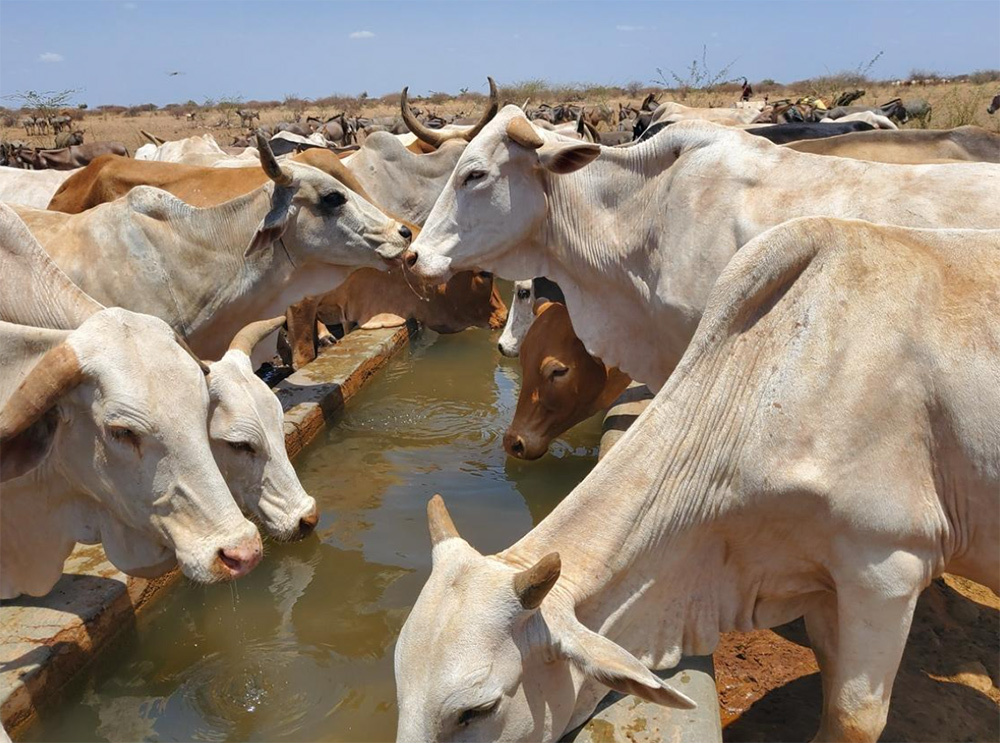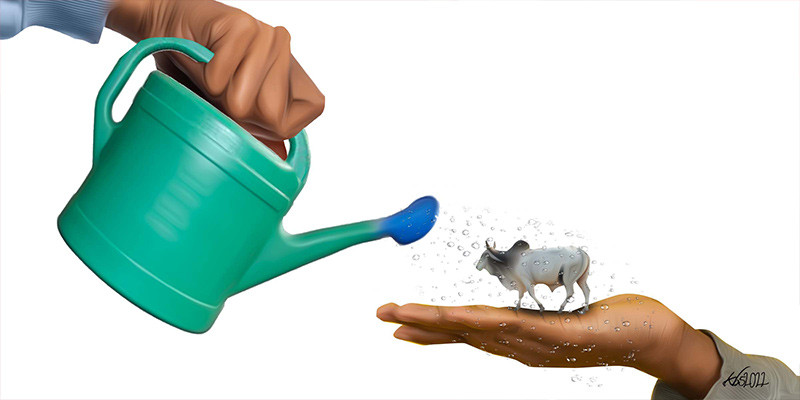Kenya’s arid and semi-arid lands (ASALs) occupy 80 per cent of the country’s landmass and are inhabited by nearly ten million people who rely on livestock rearing and seasonal small-scale farming for their livelihoods. ASALs are known for the variable environmental conditions that result in periodic drought, floods, animal disease outbreaks, and social instability due to conflict and historical marginalisation.
In the 1970s, ASALs experienced periods of prolonged drought nearly every four years, with the government and donor agencies developing various programmes through international and local NGOs to address the crises. The focus was on humanitarian aid to enhance food security through food relief aid to vulnerable populations. But due to the temporality and inefficiency of food aid, these agencies promoted farming as an alternative to livestock production and as a means of ensuring food security.
In Isiolo County, irrigation schemes were introduced along the Waso River and in other small centres such as Malka Daka and Rapsu. However, the projects failed largely due to flooding, and also because pastoralists re-invested the proceeds from farming in livestock and abandoned farming altogether.

Humanitarian interventions and the food security approach were dropped in favour of livestock development projects in the 1990s. These involved the development of water infrastructure such as boreholes and water pans, the establishment of grazing blocks and the implementation of livestock restocking programmes following periods of severe drought.
Between 1990 and 2000, the Arid Lands Resource Management Projects (ALRMP) emerged as the scaffold for the management and development of the drylands. The projects ranged from water infrastructure development and rehabilitation, to early warning bulletins, contingency planning, range re-seeding, livestock feeds, and vaccination.
The National Drought Management Authority (NDMA) took over from Arid Lands Development Projects in 2005. The NDMA’s focus is predominantly on the early warning bulletin, drought intervention, contingency policies, and capacity building. Although the NDMA is not oriented towards development projects, key policies such as Ending Drought Emergencies (EDE) form a significant segment of the NDMA’s work.

Between 2009 and 2019, social protection programmes based on cash transfers—such as the Hunger Safety Net Programme (HSNP) and livestock insurance—made their appearance. The HSNP was initially implemented in Marsabit, Mandera, Turkana, and Wajir. In 2019, the programme was upscaled to include four other pastoral counties: Isiolo, Samburu, Garissa and Tana River.
In 2010, Kenya became the first African country to implement KLIP, an index-based livestock insurance programme where the government purchases the policy on behalf of the beneficiary and disburses the pay-out as a safety net to cushion against drought events. The government first piloted the programme in Marsabit County and by 2016 had expanded the scheme to Isiolo, Mandera, Wajir, Garissa, Kajiado, Turkana, Tana River and Samburu counties.
The paradigm shifted from livestock development to enhancing “resilience” through programmes such as the Drought Resilience and Sustainable Livelihoods Programme (DRSLP), the Regional Pastoral Livelihoods Resilience Project (RPLRP) and the Resilience and Economic Growth in Arid Lands (REGAL-AG) project. “Resilience” projects aimed to accelerate economic growth by promoting the development of livestock market facilities and regulatory frameworks, developing the capacities of individual and community enterprises and promoting investments in livestock value chains in five pastoral counties (Marsabit, Isiolo, Garissa, Wajir and Turkana).
Finally, the Kenya Climate-Smart Agriculture Project (KCSAP, 2017-2026) has recently taken the lead. The implementation of KCSAP in ASAL counties enmeshes improving water systems (boreholes), livelihood support, contingency emergency response, and value addition in agriculture.

In the period between 1970 and 2020, massive investments were made to mitigate the effects of drought in Kenya’s ASALs. What I have presented here is simply a snapshot of the billion-dollar investments made in drought management. Although some of these projects have contributed to improving the resilience of pastoralist communities, others have increased their vulnerability and inequality because of the manner in which droughts and related catastrophes are handled. Following the severe drought that affected the entire Horn of Africa, including Kenya, in 2011 a policy framework was developed to end drought emergencies. But can these continuous policy shifts and the massive investments in drought management end drought emergencies in Kenya?
End drought emergencies by 2022?
Ending Drought Emergencies (EDE) is a policy framework developed to strengthen drought management institutions and infrastructure. It emerged from the regional drought and disaster resilience summit held in Nairobi by IGAD member states and regional actors. The conference aimed to respond to the drought cataclysm that had affected the entire region resulting in an estimated US$12.1 billion in drought-related losses between 2008 and 2011.
Although some of these projects have contributed to improving the resilience of pastoralist communities, others have increased their vulnerability and inequality.
In Kenya, EDE is a distinct part of the Vision 2030 sector plan for drought risk management with the stated aim of ending drought emergencies by 2022 (MTP III). EDE aims to prioritise inclusive economic growth and reduce poverty by integrating various pillars of the Sustainable Development Goals (SDGs) and the Regional Drought Disaster Resilience and Sustainability Initiative (IDIRSI). However, in September 2021, Kenya’s President Uhuru Kenyatta declared the ongoing drought a national disaster and called for local and international interventions.
Is Kenya’s roadmap for ending drought emergencies realistic? Can Kenya achieve its vision of ending drought emergencies by 2022? The same development visions and plans that aim to integrate ASAL areas into the broader economic transformation continue to push pastoralism to the periphery. Mobility is central to how pastoralists exploit variable range resources. However, insecurity, restricted park and conservancy enclosures, and mega-development infrastructures impede pastoral mobility, fostering vulnerability among the pastoralist communities rather than enhancing their resilience.
Which way forward
Despite the massive investments in humanitarian aid, pastoral development projects, resilience building and “climate-smart” approaches to drought mitigation, pastoralists remain susceptible to shocks and stresses brought on by droughts. There are remarkable discrepancies between the value of the investments made and the results achieved in attempting to end the drought emergency.
The same development visions and plans that aim to integrate ASAL areas into the broader economic transformation continue to push pastoralism to the periphery.
Both failures and successes are evident, but there is an urgent need to close the gap between the levels of investments in drought management and the impact on vulnerability and resilience. As one research participant commented, “stop subsidising failures” and instead focus on supporting the existing institutions and infrastructures that have been put in place to counter drought events. One example is the livestock market facilities and abattoirs in the rangelands, which, according to some of my research respondents, have created “drought millionaires” but have had a limited impact on the lives of pastoralists. These failures are due to a lack of a sustainable and favourable framework. To foster resilience—the ability to withstand climatic shocks and bounce back better—there is a need for a collaborative effort by all the actors, including the state, Civil Society Organisations, international actors and the pastoralists themselves. In summary, three points are essential to reflect upon.
Recognising failures and successes
The government and humanitarian organisations have developed numerous drought management policies, programmes and projects. Handling drought emergencies requires a process of un-learning, learning, and re-learning by revisiting historical interventions and policies. This will help to uncover successes, the ramifications of drought responses, and the unintended structural conditions created by such interventions. Drought response must include considering other factors such as seasonal stress, access to resource infrastructures, and the population’s social-economic dynamics that influence how drought is perceived and managed—all these help in recognising and embracing drought as a management failure rather than as a cyclical absence of rain.
Pastoralism as a reliable profession
Pastoralists are “reliability” professionals acting in “real time” by galvanising different networks, solidarities and resources. Sometimes, reliability is generated by negotiated access to restricted areas such as parks and conservancy areas and through adaptive mobilities and collective solidarities in the form of a moral economy. Collective solidarities help pastoralists to deal with labour deficit, insecurity, and access to resources. Although these practices of collective solidarity are sometimes stratified between people with networks, wealth, and other resources, they remain central to how diverse livestock owners navigate dry periods. External projects that aim to enhance pastoral resilience must recognise the existence of reliable institutions that help pastoralists to manage precarious conditions such as drought. Recognising pastoralists as active managers of drought crises and real-time coordination between pastoralists, state and development NGOs will enhance reliability and adaptive containment of drought emergencies.
Proactive approach
Policies that deal with drought management—such as early warning and contingency planning—are sometimes linear, progressive, and reactive. In contrast, drought events are very much unpredictable and require considerable multiple knowledge and open-ended approaches.
To contain drought emergencies, there is a need to embrace the participatory, relational, and open-ended perspective. In the words of one of my research respondents, “there is a need to move from the ‘policy’ classroom to the ‘field’ classrooms”. For instance, livestock market infrastructure is in place in most parts of the rangelands, but unfortunately, some of it is derelict. Instead of jumping from project to project in search of a short-term response, there is a need to embrace practical and proactive long-term solutions. These could provide stability in the rangelands, especially during dry periods, to help pastoralists exploit unevenly distributed resources. One suggestion could be integrating pastoralists’ safety net and the moral economy with the social protection projects in pastoral areas.
There should be a “pause” moment to rethink and reflect on how to embrace the drought emergencies and build forward better by turning the drought crisis into an opportunity for sustainable and reliable livelihoods in the ASALs and beyond.








